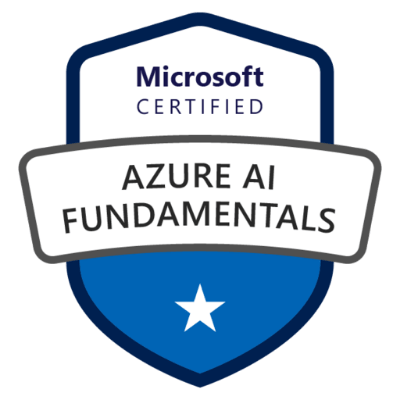Microsoft Azure AI Training
AI-900T00-A: Microsoft Azure AI Fundamentals
Prepare to pass the AI-900: Microsoft Azure AI Fundamentals Certification Exam


Course Description
This course introduces fundamentals concepts related to artificial intelligence (AI), and the services in Microsoft Azure that can be used to create AI solutions. The course is not designed to teach students to become professional data scientists or software developers, but rather to build awareness of common AI workloads and the ability to identify Azure services to support them. The course is designed as a blended learning experience that combines instructor-led training with online materials on the Microsoft Learn platform. The hands-on exercises in the course are based on Learn modules, and students are encouraged to use the content on Learn as reference materials to reinforce what they learn in the class and to explore topics in more depth.
Audience Profile
The Azure AI Fundamentals course is designed for anyone interested in learning about the types of solution artificial intelligence (AI) makes possible, and the services on Microsoft Azure that you can use to create them. You don’t need to have any experience of using Microsoft Azure before taking this course, but a basic level of familiarity with computer technology and the Internet is assumed. Some of the concepts covered in the course require a basic understanding of mathematics, such as the ability to interpret charts. The course includes hands-on activities that involve working with data and running code, so a knowledge of fundamental programming principles will be helpful.
About this Course
Course Outline
Skills at a glance
Describe Artificial Intelligence workloads and considerations (15–20%)
Describe fundamental principles of machine learning on Azure (20–25%)
Describe features of computer vision workloads on Azure (15–20%)
Describe features of Natural Language Processing (NLP) workloads on Azure (15–20%)
Describe features of generative AI workloads on Azure (15–20%)
Describe Artificial Intelligence workloads and considerations (15–20%)
Identify features of common AI workloads
Identify features of content moderation and personalization workloads
Identify computer vision workloads
Identify natural language processing workloads
Identify knowledge mining workloads
Identify document intelligence workloads
Identify features of generative AI workloads
Identify guiding principles for responsible AI
Describe considerations for fairness in an AI solution
Describe considerations for reliability and safety in an AI solution
Describe considerations for privacy and security in an AI solution
Describe considerations for inclusiveness in an AI solution
Describe considerations for transparency in an AI solution
Describe considerations for accountability in an AI solution
Describe fundamental principles of machine learning on Azure (20–25%)
Identify common machine learning techniques
Identify regression machine learning scenarios
Identify classification machine learning scenarios
Identify clustering machine learning scenarios
Identify features of deep learning techniques
Describe core machine learning concepts
Identify features and labels in a dataset for machine learning
Describe how training and validation datasets are used in machine learning
Describe Azure Machine Learning capabilities
Describe capabilities of automated machine learning
Describe data and compute services for data science and machine learning
Describe model management and deployment capabilities in Azure Machine Learning
Describe features of computer vision workloads on Azure (15–20%)
Identify common types of computer vision solution
Identify features of image classification solutions
Identify features of object detection solutions
Identify features of optical character recognition solutions
Identify features of facial detection and facial analysis solutions
Identify Azure tools and services for computer vision tasks
Describe capabilities of the Azure AI Vision service
Describe capabilities of the Azure AI Face detection service
Describe features of Natural Language Processing (NLP) workloads on Azure (15–20%)
Identify features of common NLP Workload Scenarios
Identify features and uses for key phrase extraction
Identify features and uses for entity recognition
Identify features and uses for sentiment analysis
Identify features and uses for language modeling
Identify features and uses for speech recognition and synthesis
Identify features and uses for translation
Identify Azure tools and services for NLP workloads
Describe capabilities of the Azure AI Language service
Describe capabilities of the Azure AI Speech service
Describe features of generative AI workloads on Azure (15–20%)
Identify features of generative AI solutions
Identify features of generative AI models
Identify common scenarios for generative AI
Identify responsible AI considerations for generative AI
Identify capabilities of Azure OpenAI Service
Describe natural language generation capabilities of Azure OpenAI Service
Describe code generation capabilities of Azure OpenAI Service
Describe image generation capabilities of Azure OpenAI Service
Duration
1 Day
Prerequisites
none
Level
Beginner
Product
Azure
Role
AI Engineer
